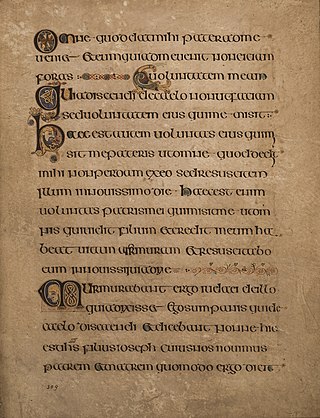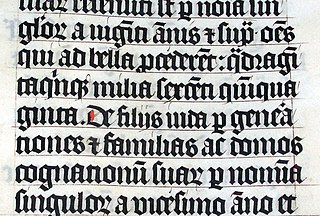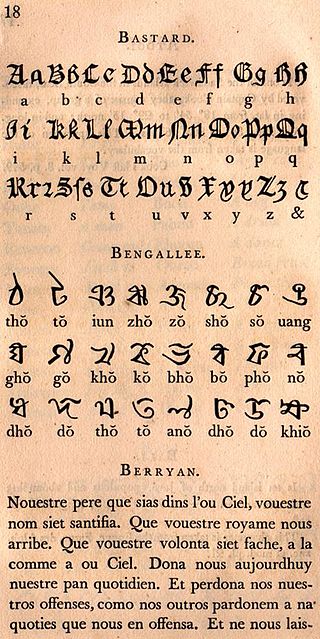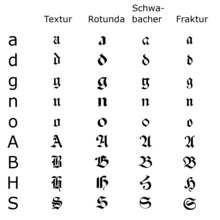
R, or r, is the eighteenth letter of the Latin alphabet, used in the modern English alphabet, the alphabets of other western European languages and others worldwide. Its name in English is ar, plural ars, or in Ireland or.

Calligraphy is a visual art related to writing. It is the design and execution of lettering with a pen, ink brush, or other writing instrument. Contemporary calligraphic practice can be defined as "the art of giving form to signs in an expressive, harmonious, and skillful manner".

Uncial is a majuscule script commonly used from the 4th to 8th centuries AD by Latin and Greek scribes. Uncial letters were used to write Greek and Latin, as well as Gothic, and are the current style for Coptic and Nobiin.

Fraktur is a calligraphic hand of the Latin alphabet and any of several blackletter typefaces derived from this hand. It is designed such that the beginnings and ends of the individual strokes that make up each letter will be clearly visible, and often emphasized; in this way it is often contrasted with the curves of the Antiqua (common) typefaces where the letters are designed to flow and strokes connect together in a continuous fashion. The word "Fraktur" derives from Latin frāctūra, built from frāctus, passive participle of frangere, which is also the root for the English word "fracture". In non-professional contexts, the term "Fraktur" is sometimes misused to refer to all blackletter typefaces – while Fraktur typefaces do fall under that category, not all blackletter typefaces exhibit the Fraktur characteristics described above.

Carolingian minuscule or Caroline minuscule is a script which developed as a calligraphic standard in the medieval European period so that the Latin alphabet of Jerome's Vulgate Bible could be easily recognized by the literate class from one region to another. It is thought to have originated before 778 CE at the scriptorium of the Benedictine monks of Corbie Abbey, about 150 kilometres north of Paris, and then developed by Alcuin of York for wide use in the Carolingian Renaissance. Alcuin himself still wrote in a script which was a precursor to the Carolingian minuscule, which slowly developed over three centuries. He was most likely responsible for copying and preserving the manuscripts and upkeep of the script. It was used in the Holy Roman Empire between approximately 800 and 1200. Codices, pagan and Christian texts, and educational material were written in Carolingian minuscule.

Cursive is any style of penmanship in which characters are written joined in a flowing manner, generally for the purpose of making writing faster, in contrast to block letters. It varies in functionality and modern-day usage across languages and regions; being used both publicly in artistic and formal documents as well as in private communication. Formal cursive is generally joined, but casual cursive is a combination of joins and pen lifts. The writing style can be further divided as "looped", "italic", or "connected".

Blackletter, also known as Gothic script, Gothic minuscule or Gothic type, was a script used throughout Western Europe from approximately 1150 until the 17th century. It continued to be commonly used for Danish, Norwegian, and Swedish until the 1870s, Finnish until the turn of the 20th century, Latvian until the 1930s, and for the German language until the 1940s, when Hitler officially discontinued it in 1941. Fraktur is a notable script of this type, and sometimes the entire group of blackletter faces is referred to as Fraktur. Blackletter is sometimes referred to as Old English, but it is not to be confused with the Old English language, which predates blackletter by many centuries and was written in the insular script or in Futhorc. Along with Italic type and Roman type, blackletter served as one of the major typefaces in the history of Western typography.

Antiqua is a style of typeface used to mimic styles of handwriting or calligraphy common during the 15th and 16th centuries. Letters are designed to flow, and strokes connect together in a continuous fashion; in this way it is often contrasted with Fraktur-style typefaces where the individual strokes are broken apart. The two typefaces were used alongside each other in the germanophone world, with the Antiqua–Fraktur dispute often dividing along ideological or political lines. After the mid-20th century, Fraktur fell out of favor and Antiqua-based typefaces became the official standard in Germany.

The r rotunda ⟨ ꝛ ⟩, "rounded r", is a historical calligraphic variant of the minuscule (lowercase) letter Latin r used in full script-like typefaces, especially blackletters.

Western calligraphy is the art of writing and penmanship as practiced in the Western world, especially using the Latin alphabet.

Scribal abbreviations, or sigla, are abbreviations used by ancient and medieval scribes writing in various languages, including Latin, Greek, Old English and Old Norse.

Italic script, also known as chancery cursive and Italic hand, is a semi-cursive, slightly sloped style of handwriting and calligraphy that was developed during the Renaissance in Italy. It is one of the most popular styles used in contemporary Western calligraphy.

Lettering is an act or result of artfully drawing letters, instead of writing them simply. Lettering is considered an art form, where each letter in a phrase or quote acts as an illustration. Each letter is created with attention to detail and has a unique role within a composition. Lettering is created as an image, with letters that are meant to be used in a unique configuration. Lettering words do not always translate into alphabets that can later be used in a typeface, since they are created with a specific word in mind.

Secretary hand or script is a style of European handwriting developed in the early sixteenth century that remained common in the sixteenth and seventeenth centuries for writing English, German, Welsh and Gaelic.

Bastarda or bastard was a blackletter script used in France, the Burgundian Netherlands and Germany during the 14th and 15th centuries. The Burgundian variant of script can be seen as the court script of the Dukes of Burgundy. The particularly English forms of the script are sometimes distinguished as Bastarda Anglicana or Anglicana.

The term "chancery hand" can refer to either of two distinct styles of historical handwriting.

Round hand is a type of handwriting and calligraphy originating in England in the 1660s primarily by the writing masters John Ayres and William Banson. Characterised by an open flowing hand (style) and subtle contrast of thick and thin strokes deriving from metal pointed nibs in which the flexibility of the metal allows the left and right halves of the point to spread apart under light pressure and then spring back together, the popularity of round hand grew rapidly, becoming codified as a standard, through the publication of printed writing manuals.

Court hand was a style of handwriting used in medieval English law courts, and later by professionals such as lawyers and clerks. "It is noticeably upright and packed together with exaggeratedly long ascenders and descenders, the latter often and the former occasionally brought round in sweeping crescent shaped curves".

Humanist minuscule, or whiteletter, is a handwriting or style of script that was invented in secular circles in Italy, at the beginning of the fifteenth century. "Few periods in Western history have produced writing of such great beauty", observes the art historian Millard Meiss. The new hand was based on Carolingian minuscule, which Renaissance humanists took to be ancient Roman:
[W]hen they handled manuscript books copied by eleventh- and twelfth-century scribes, Quattrocento literati thought they were looking at texts that came right out of the bookshops of ancient Rome".

Ronde is a kind of script in which the heavy strokes are nearly upright, giving the characters when taken together a round look. It appeared in France at the end of the 16th century, growing out from a late local variant of Gothic cursive influenced by North Italian Renaissance types in Rotunda, a bookish round Gothic style, as well as Civilité, also a late French variant of Gothic cursive. It was popularized by writing masters such as Louis Barbedor in the 17th century.























